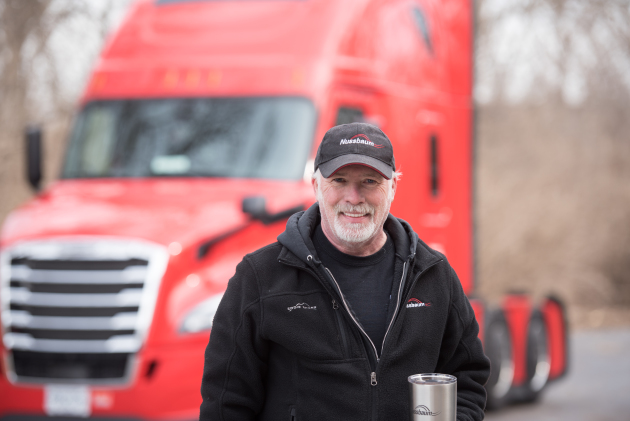Four habits of highly-efficient drivers
TORONTO, Ont. — Why spend money on fuel that you can save? That’s what fuel-efficient drivers believe and live by.
We spoke with drivers that participated in the North American Council for Freight Efficiency (NACFE) Run on Less fuel economy challenge last year, to ask them what they do on a daily basis to keep their mpg in the double-digit range.

Slow down
For Clark Reed, who’s been driving professionally for 13 years, speed and fuel economy go hand-in-hand.
“I run 60 mph unless it’s not safe to do so,” he said. “Or unless I have a load that has a tight window, so then I’ll run a bit faster. A lot of guys don’t like to hear that. No one wants to drive 60 mph, but that’s the biggest way you can improve your bottom line.”
And he would know. Reed, a driver for Nussbaum, said he usually averages more than 10 mpg per week.
“Just last week, I hit 11.1 miles to the gallon, actually,” he said in an interview with Truck News. “But I drive to conditions. I’m slowing down when I can. I’m not driving top speed, full speed ahead because that’s one way for fuel to go right to the exhaust pipe.”
But speed can be a balancing act, explained independent owner-operator Henry Albert, who also averages more than 10 mpg.
“Speed is a daily decision for me,” he said. “And some people get caught up in it. It is a major factor. But if there’s more revenue to be generated by going faster, and I know that…I’ll drive what the speed limit will allow me. By contrast, if I know I’m going to get there, and the place will be closed anyway, and I’m going to be sitting there, then I’ll slow down safely.”
A recently released study by SmartDrive supports Reed’s theory. It found drivers who speed suffer a 2.7% fuel economy penalty compared to those who don’t.
Ease up on the pedal
“The main thing for me is to be soft on the pedal,” Reed said. “So instead of mashing down on the pedal to keep going faster, or mashing on the brake to slow down, you have to take an easier approach to it. I always drive like I’m on ice all the time. Lighter on the pedal means less fuel to accelerate, lighter on the brake and it’s less fuel to accelerate again. If I can avoid having to stop through a light, I’ll do it so I don’t have to stop and accelerate again.”
Albert agreed, saying the trick he uses to remember to stay easy on the pedal is an adage he learned from a trainer.
“Drive like you’ve got a raw egg between your foot and the throttle,” he said.
Albert calls this method heat management.
“You don’t want to be on the throttle and then off the throttle all the time,” he said. “You want to create a smooth pace. You want to be steadier on the pedal. I like to think of it as, a good driver is a manager of heat. Everything you do creates heat with a truck, whether it’s on the throttle, on the brakes – it comes out of your fuel tank. Brakes would never make heat if you never moved the truck. So really what you’re trying to do is get from Point A to Point B and create as little heat as possible to do that.”
Inflate-gate
Keeping your tires properly inflated is also a way to save money at the pumps, Reed said.
“Tire inflation is a big thing. Keeping your tires inflated properly can really help your fuel mileage. And even just a little underinflation can affect your numbers a lot.”
Reed says the truck he drives comes with an automatic tire inflation system that warns him in the cab if tire pressure is too low, if the tire gets too hot, or if there is a leak. He manually checks his tire pressures during his pre-trips and only when they’re cold.
“I keep the steer tires at 110 psi, and super singles at 120 psi,” he said.
No decision is too small
According to Albert, great fuel mileage starts with a great truck that is spec’d well.
“I drive a 2018 Cascadia,” he said. “And I have the aerodynamic package. From there I have a nose cone on the trailer. I keep the gap tight. I have side skirts, trailer tails, and I moved my licence plate. I also have wheel covers. And low-rolling resistance tires.”
And every one of these small spec’s help his fuel mileage in a big or small way, Albert said.
“Everything matters,” he said. “You go around to so many people and they say ‘well that doesn’t make much difference,’ and if you put enough of those not-make-much-differences together, it makes a difference. And really when you’re starting to get a tenth here and a tenth there, it’ll add up to a full mile to the gallon. In my case, even how I have my trailer licence plate mounted helps. Typically, they’re mounted by the tail lights, right in the air stream, and I moved mine onto the rear bump plate so it’s out of the air stream.”
Have your say
This is a moderated forum. Comments will no longer be published unless they are accompanied by a first and last name and a verifiable email address. (Today's Trucking will not publish or share the email address.) Profane language and content deemed to be libelous, racist, or threatening in nature will not be published under any circumstances.
Great tips now only for truck drivers but for any driver.